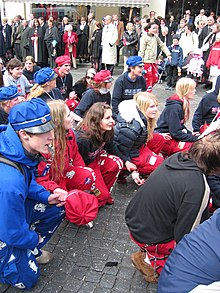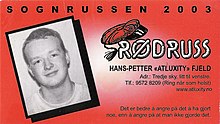Soot celebration


Russ and Russefeiring ( Russ and Russfeier ) are a Norwegian cultural phenomenon that has its origins in Danish traditions. As soon as students have finished the “videregående skole” ( secondary school , corresponds to the German upper school), they call themselves “Russ” and show this through celebrations and special customs such as Russian hats, ID cards and pictures. The celebrations reach their climax on May 17th, Norway's national holiday , when a soot parade takes place in many places after the classic children's parade. This move marks the end of the "Russetiden". Other traditions include the Russrevue and the Russzeitung, which is mostly sold on May 17th. In Norway, a distinction is traditionally made between the so-called rødruss ( Red Russians ), who have graduated from high schools, and blåruss ( Blue Russians ), who have graduated from commercial high schools . The activities for the Russian celebration are not organized by the schools, but by the students themselves.
history
Etymology and Background
The word “Russ” comes from the Latin language ( cornua depositurus ), which in German can be freely translated as “to repel one's horns”. The Russ celebration itself dates back to the 17th century. Since there was no university of its own in Norway at that time, the Norwegians mostly studied in Copenhagen . The University of Copenhagen was then called Universitas Hafniensis . The Norwegian-Danish writer Ludvig Holberg wrote the following in his 1722 comedy Erasmus Montanus :
“ The he come profecto en raised Russer til Kiøbenhavn. - Hvad mon Russians nu vil bestille her igien? - Det er ikke Moscoviter, Jeppe Berg! Det er unge students, som man kalder Russer. "
In order to gain access to the course, the students had to pass an examen artium (equivalent to the Abitur). When the exam was over, they were given a horn on their heads and were ridiculed by the older students. Later, when the results were known, the students were at a ceremony called examen depositiones . Here they placed themselves in front of the exam candidates; when these passed, the horn was removed as a sign of wisdom and maturity. Only then could the students call themselves students.
Another theory about the origin of the word is that it comes from the Latin rus , which can be interpreted as "farming country" (see also rustic ). Rus may therefore have been used as a swear word for students with bad manners. The spelling with two s - ie "russ" - was probably chosen to delimit the word "rus", which means intoxication in Norwegian .
Although celebrations in both Sweden and Denmark are now cautiously approaching Norwegian celebrations, this institution has a strong tradition that goes back to the 17th century. The Russ and student celebrations in the north are based on the high status of high school education.
In Norway

The current Norwegian Russian tradition has been described since 1905, when red Russian hats were first used by outgoing students from the high school in Kristiania (today: Oslo ). These hats were initially only used by the boys and were inspired by German students who visited Norway in 1904. In 1916, the blue caps were first used by Russians at the commercial high school in Oslo.
In 1979, the Workers' Party decided to put the exam days later than May 17th in order to limit the wild Russian celebrations and to give the students more time to prepare for technical exams.
For a long time, the Russians' hats and a simple bamboo stick with a colored bow were the only equipment of the Russians. Later I added my own clothes, large buses and other things; Today the Russian celebrations have a strong influence on accessory suppliers and clothing importers. It is also important to wear dungarees from May 1st.
In Denmark and Sweden
The tradition of celebrating university admission can also be found in Denmark and Sweden. The new students are called "rus" (Denmark) or "russ" (Sweden) and wear a "Russ mark" in the first few weeks of their studies. These celebrations are very different depending on the type of student. In Sweden, for example, it can be a student revue, in Denmark it can be a tour in a flatbed truck decorated with birch twigs .
Students in Denmark, Sweden, and Finland dress in white hats, a tradition from the mid-18th century. These students are called studenterhue (Danish) and studentmössa (Swedish). Individual Swedish Russians also wear special colored costumes. Since the old student examination in Sweden was abolished in 1969, the student celebrations there are now very reserved. In the past, for example, high school students could wear their white student hats all summer until they started studying in the fall.
Nonetheless, student parties in Sweden have seen a boom in recent years. Now these are usually initiated with the so-called mösspåtagning , a kind of “soot baptism”.
In Sweden, too, customs now vary from place to place.
Russ today
Depending on where you study in the country, the Russian celebrations begin in the fall of last year at secondary school or towards the end of April / beginning of May and last until May 17 or even longer. The Russians receive their final exams after the celebration; so it may be that failed students can be Russ again next year. Too wild and rampant partying can of course lead to poor grades in the exam, which only takes place after the Russian celebrations.
Soot types

There are several types of Russians with different local variants, these are the most common:
- Rødruss ( Rotruss ) are students in the general grammar school.
- Blåruss ( Blue Russ ) are students in business schools.
- Svartruss ( Schwarzruss ) are vocational school students .
- Grønnruss ( Grünruss ) have been vocational students in agriculture and forestry since around 2005 (until then Svartruss). The Grønnruss were originally secondary school students until the secondary school was abolished in 1968 and replaced by the ungdomsskole .
- Oransjeruss ( orange nut ) are the (three years younger) graduate students of the ungdomsskole (comparable to the completion of the intermediate level).
- Rosaruss ( Rosaruss ) is a child who completes kindergarten.
The tradition of the last three types is not very widespread, however.
Russian costume, hat and "Knutergler"
In conjunction with the Russ events, usually in the spring, the Russians in red or blue "uniforms" for example dress blue men or carpenter pants in Russ color, often decorated with badges. Long tufted hats have a long tradition. Various types of knots are tied in this tuft, often with small objects. These knots are a symbol for the implementation of the so-called "Knutgler" (tests of courage). This is often criticized because it can include criminal acts (such as exposure) and potentially dangerous acts (such as ingesting large amounts of alcohol in a short period of time). The first Knut regulators emerged in the 1940s.
The soot celebrations begin with a soot baptism in May. There the peak of the Russian hat can be painted with the owner's name. The hats are a non-festive variant of the traditional black hat that students wear at the final official exam ceremony. This black cap is then the actual sign that the exam has been passed.
Soot cars
The tradition of their own “Russautos” originated in the 1960s. The Russians bought or took over old cars, which were painted red or blue and provided with nonsense texts and advertisements. With increasing pressure and better economic conditions, this custom has now developed into an expensive Russian bus, which has been planned for years. The Russbuses can have a special facility as well as large sound and light systems on the roof, in individual cases several hundred thousand crowns are invested there. This is especially true in Oslo and Akershus .
The Russautos were originally used in the parade on May 17th, but for many they were also a practical and necessary means of transport, but often just a community-binding hobby during the Russians. The cars are mostly financed through advertising.
Soot card
Every single soot has a soot card. This is a personal business card with the Russian motto, name and picture printed on it. These are mostly standardized, but often have a crazy look. These cards are exchanged between the Russians or distributed to family members and children.
Russzeitung
The first Russian newspaper appeared in 1919.
Russeruf
The regular call Chickelacke was created in Oslo in 1934 based on the example of a Danish boy scout call . This will continue to be used on the Russian trains on May 17th:
- Chickelacke, chickelacke, show, show, show
- Bummelacke, bummelacke, bow, bow, bow
- Chickelacke, loafers, jazz bom bøh
- Julekake, julekake, hjembakt brød
(Nonsense text without content; the last line translates as: "Christmas cake, Christmas cake, home-baked bread")
criticism
The Russian celebrations are regularly criticized in the mass media, but also by individual school principals because of their dangerous Russian cars, waste of money, exaggerated celebrations with harmful alcohol consumption, sexual assault, vandalism and bullying of younger citizens. Most Russians consider the criticism to be unjustified and point out that these are only isolated cases.
The behavior of the Russ is usually explained as a result of the youth's thirst for action and the need for freedom and fun after 12 (after school reform 13) years of schooling. Peer pressure , drug use, immaturity and lack of experience also play a major role.
Soot culture as a rite of passage

Allan Sande from the Bodø University of Applied Sciences treated the Russian period as the liminal phase of life in his doctoral thesis . This means that the Russetid is a rite of passage in which one clarifies and opposes social norms in order to emerge as an adult, responsible individual. Parallel phenomena can be found in many cultures. This applies, for example, to the Carnival in Rio, an ancient tribal ritual in Africa and earlier community celebrations in connection with funerals or weddings. Allan Sande also thinks that the Russian celebrations can be seen as a parody or caricature of the community. At the same time, he claims that these enable young people to have new experiences and train them in independence, planning, structure and cooperation.
Nowadays there are opinions that predict a significant increase in the popularity of Russian celebrations in the future and that classic rituals such as confirmation , military service and the beginning of working life could lose their importance.
Others
The term blåruss is also used in political debates and speeches as a derogatory and ironic term for politicians who place a one-sided weight on economic-rational judgments. The word is often used by the extreme parties.
credentials
- ↑ rustic in the Wiktionary
- ↑ Sigrid Harms: The month of the dungarees. Sex and partying: Norwegians are considered reluctant - unless they are just doing their high school graduation. In: Frankfurter Rundschau, May 16, 2018, p. 40
- ^ Allan Sande: Russefeiring and Nationalism in Norway. The relationship between alcohol consumption, youth integration and May 17th . Norrøna 42, 2008
literature
- Jan Johannessen: Lenge leve russen - en seriøs humor and kavalkadebok om russian history . Oslo, eget forlag, 1982. ISBN 82-990854-0-3
- Anne-Sofie Hjemdahl: Kledd i russetid - en samtidsstudie av rødrussens klær . Hovedoppgave i etnologi ved Universitetet i Oslo, 1999
- Allan Sande: RUSsefeiring - om meningen med rusmiddelbruk sett gjennom russefeiring som et ritual . Høgskolen i Bodø, 1999. ISBN 82-7314-286-8 . Avhandling (dr. Polit.) Ved Universitetet i Tromsø, 2000
